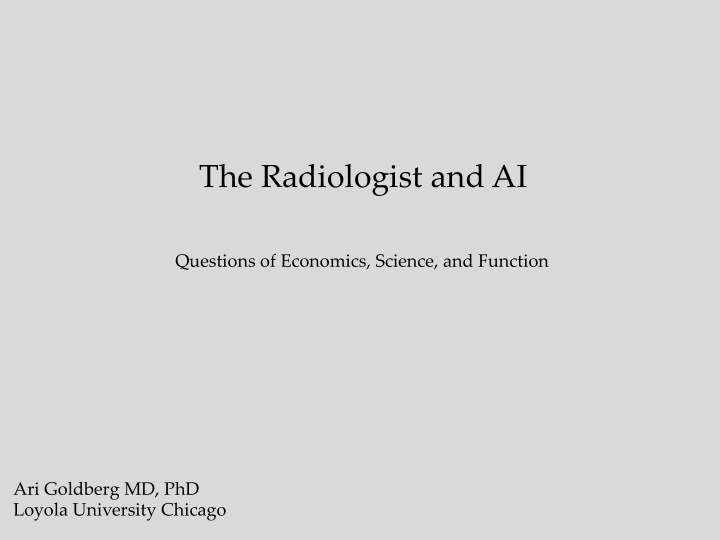



The Radiologist and AI Questions of Economics, Science, and Function Ari Goldberg MD, PhD Loyola University Chicago
What many Radiologists hear:
The Reality We are already seeing some impatience with AI and its Radiology adoption
In fact, investment fell for first time recently:
Resistance
Nevertheless…
The Radiologist ’ s Role? • So, reality is different from anticipated • However – Large economic drivers for AI advancement persist – Significant upsides to individual practice and large-scale healthcare • Unique role/time for Radiologists to affect future care and policy – Where do we focus? • More efficiency or better diagnostic performance? • Improve what we do or shift to new paradigm? • Data brokers?
Enhanced productivity • Faster reads = More reads – Lesion detection – Lesion measurement – Triage (X-rays with ptx) – Relevant supporting patient data and EHR • Dashboards • Automated clinician notification • Faster scans – AI-driven workflow – AI-driven image reconstruction • MRI iterative + AI recon schemes • CT dose reduction • Potential for increases in efficiency in US to have global impact
Diagnosis / Fewer Misdiagnoses • Detection – Lung nodules – Breast asymmetry • “Triage” – Benign vs Malignant – Acute vs Chronic • Bleed • Mass • Virtual Pathology = most sophisticated – Adenocarcinoma vs Squamous – Mets vs Primary
Challenges of Diagnosis • Supervised learning – Machine Learning algorithm in which the system is presented with labelled or annotated examples from which to learn – Partially limited by radiologist guidance and data annotation • Example = Training prostate MRI software with PI-RADS scoring from radiologist – Most common, requires less data • Unsupervised and Deep learning – Machine Learning algorithm must infer inherent structure of the data, grounded with outcomes and pathology • Prostate MRI training with pathology only – Neuronal mimicry to learn how to recognize complex latent patterns in the data • Radiologist fear of replacement – Important to remember: are there fewer or more airline pilots now that we have autopilot?
Case 1
Case 2
“Simplify” with additional demographic and clinical data?.....
Example from machine vision
More data = more data • As we add data to help distinguish one clinical or imaging situation from another, we add variables and thus the need for more data sets. • Estimated that true diagnosis of lung CA on lung screener CTs will require ~10 million lung CTs. • Data is valuable
Radiologists as data gatekeepers • Radiologists can (and should?) play central role in stewarding PHI data. • Much of technical aspects go beyond hospital admin and legal – Type, Relevance, and Volume of data – Method of transit/sharing – Volume – Formatting – Value
Radiologists involved in projects should know….
….and also know:
Can AI take us backward? But in a good way… • All of the above relates to making Radiologists better and faster at what we already do • Can AI provide the opportunity for Radiologists to evolve? – Radiologist as the high-level manager, using integrated approach of images and robust AI to guide disease management? – Less commoditization, more consultant and clinician • Breast radiology a template • Evolution may be necessary due to other specialties harnessing aspects of AI
Radiology + AI Special Thanks to Drs Khan Siddiqui MD and Orest Boyko MD,PhD
Recommend
More recommend